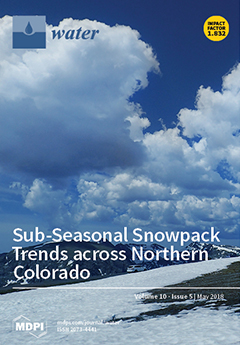This study aims to model the impacts of the frequency of cuttings of Tifton 85 bermudagrass on the dynamics of evapotranspiration (ET
c) and to derive crop coefficients appropriate for grass water management. Two seasons of experimentation were used with four different cutting treatments which provided field data for calibration and validation of the soil water balance model SIMDualKc for all treatments. Cuttings were performed after the cumulative growth degree days (CGDD) attained 124 °C, 248 °C and 372 °C, thus from short to very long intervals between cuttings. SIMDualKc adopts the Food and Agriculture Organization (FAO) dual K
c approach for partitioning ET into crop transpiration and soil evaporation, thus providing for an assessment of their dynamics. All treatments were irrigated to avoid water stress. Grass ET
c was modelled adopting a K
cb curve to describe the ET variation for each cutting cycle, that is, using the FAO K
c curve that consists of a series of K
cb curves relative to each cutting cycle. Each individual K
cb curve consisted of three segments constructed when knowing the K
cb values at the initial, at the end of rapid growth, and at cutting, respectively K
cb ini, K
cb gro and K
cb cut. These K
cb values were first estimated using the equation relating K
cb to the density coefficient (K
d), which is computed from the fraction of ground cover (f
c) and canopy height (h) at the same dates. The goodness of fit indicators relative to the calibration and validation of the SIMDualKc model were rather good, with the normalized root mean square error (RMSE) ranging from 4.0% to 6.7% of the mean available soil water. As an example, the standard K
cb values obtained after model calibration relative to the cuttings treatment with CGDD of 248 °C are: K
cb ini = 0.86, K
cb gro = 0.91 and K
cb cut = 0.96. K
cb values were smaller when the frequency of cuts was larger because h and f
c were smaller, and were larger for reduced cuttings frequency since h and f
c were then larger. Because the soil was wet most of the time, the soil evaporation K
e varied little but its value was small due to the combined effects of the fraction of crop cover and plant litter covering the soil. The values of K
c = K
cb+K
e also varied little due to the influence of K
e and the K
c curve obtained a form different from the K
cb curves, and a single K
c value was adopted for each cutting frequency, e.g., K
c = 0.99 for the treatment with CGDD of 248 °C. Results of the soil water balance have shown that, during the experimental periods, likely due to the effects of the El Niño Southern Oscillation (ENSO), runoff and deep percolation exceeded ET
c. Moreover, the soil evaporation ratio was small: 14% in case of frequent cuttings and less for more spaced cuttings, thus with a transpiration ratio close to 90%, which indicates a very high beneficial consumptive water use, mainly when cuttings are not very frequent.
Full article





